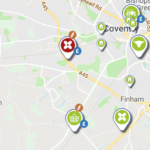What to do in your organic veg patch in September

Here is a great resource to help you grow great fruit and veg at home from our friends at Garden Organic. Like BigBarn Garden Organic work with schools to get kids growing veg and they are supporting our petition to get Food Growing on the national curriculum (please sign here).
So here is what they are suggesting to do in September:
September sunshine is special – golden and gentle. But the growing days are shorter, with dew drenched mornings and cool evenings. Now is the time to gather your harvest before frosts threaten. And save your seeds before winter sets in.
Soil matters
Use a low nutrient mulch such as leafmould or straw, or even newly fallen autumn leaves, on any bare areas

Time in the veg patch
Empty the compost bin by bagging up compost from the bottom of the bin/heap. Store it ready for use next spring. Now you are ready to start a new mix.
If you have a worm bin, bring it under cover to protect against frost. See FS Worm composting
Vegetables
See Harvesting and storage for tips – making sure that only perfect, non-bruised or damaged veg or fruit is stored.

Healthy plants
Keep weeding to prevent weeds seeding
Brassica whitefly can survive the winter on Brussels sprouts, broccoli, winter cabbage and kale. These tiny, white creatures fly up in clouds when the plants are disturbed. Their sticky honeydew often encourages black ‘sooty’ moulds to grow on leaves. Pick off infested lower leaves; the young whitefly ‘scales’ live on the underside of these. Spray both sides of remaining leaves with insecticidal soap if the infestation is bad, repeating two or three times if necessary.
Pick off any cabbage white caterpillars.
Leek rust, a fungal disease with red/orange pustules on the leaves, turns leaves yellow and stunts the plant’s growth. There is little you can do to counter it, but the good news is that the leeks are quite safe to eat, just remove affected outer growth. FS Leek rust

Prize crop
Fruit
Scatter windfall fruit around the garden as food for wildlife. Plums are a favourite of butterflies – they adore the sugary juice.
Clear all weeds around fruit bushes and trees to prevent them seeding.
Remove nets from soft fruit to allow birds to clear up pests over the winter. Cultivate the ground lightly around plants to expose pests.
Order new fruit trees and bushes; bare-root plants will be ready for delivery in November. Choose varieties that will suit the site (wind, sun, soil type etc) and cultivars that are resistant to pests or diseases. See Fruit planting and care also FS Planting fruit trees & bushes

Fresh, bird food?
Complete pruning of stone fruits (including plums and cherries) by the middle of September to avoid silver leaf disease (Chondrostereum pupureum). Cut out all affected growth and any dead wood.
Herbs
Parsley, rocket and coriander can still be sown this month.
Cut herbs for drying and use throughout the winter.
Save seeds of your organically grown herbs for next spring. Make sure they are dry, then store in airtight containers in a cool place
This is direct from Garden Organic’s website and has some great tips every month.

Your Local Food Map?
Many of our readers go on to grow their own crops, but often rather more than they really need for themselves. Please look out for places to sell your excess produce through our Crop for the Shop scheme here.
You will find places on our Local Food Map that have opted in with a carrot flag on their icon. You could even approach your local shop, pub or restaurant and supply them with fresh produce in return for a pint of beer or meal.
And please also advise them to join our map.